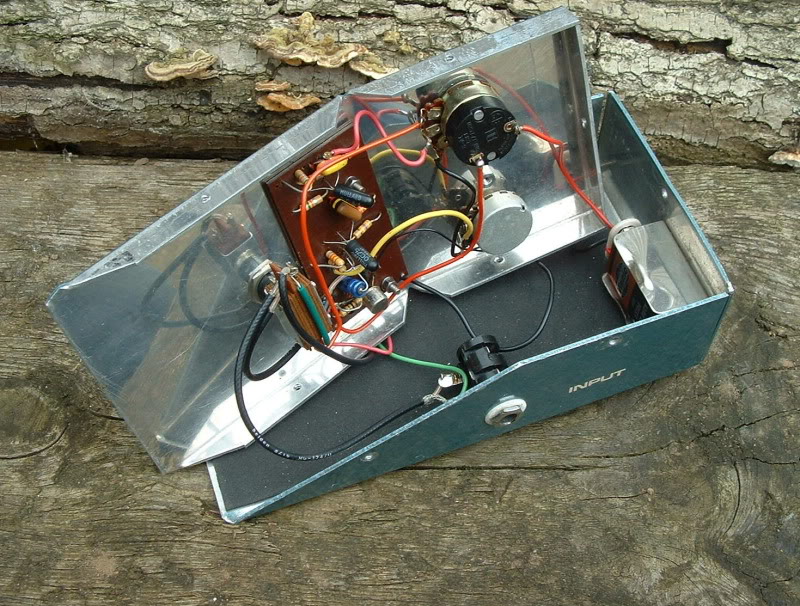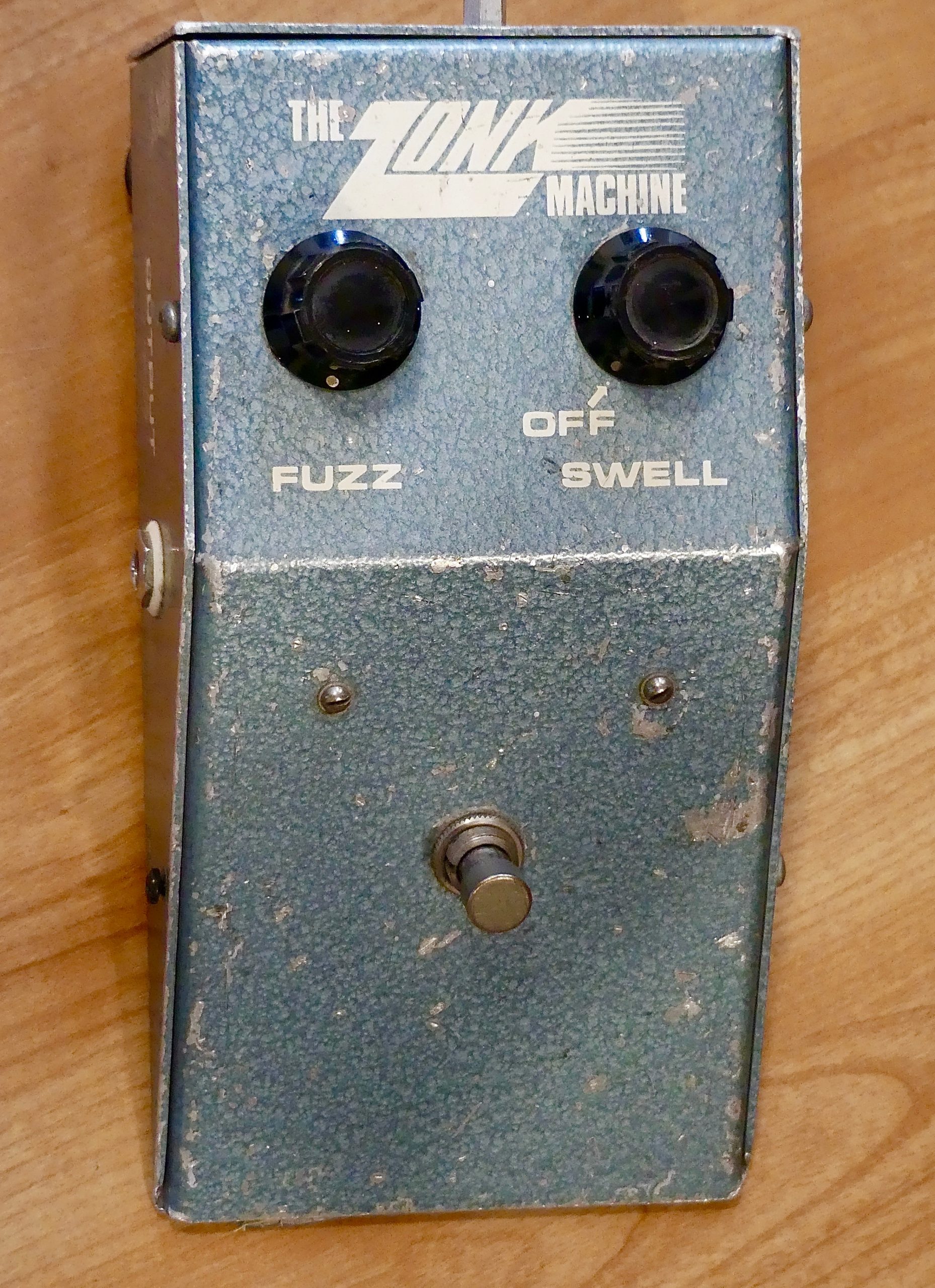History
Zonk Machine fuzz boxes were manufactured during the mid-to-late 1960s and distributed by John Hornby Skewes’ now-famous musical instruments retail company in Leeds.
Skewes recalled in 2015 that the Zonk Machine was designed by Charlie Ramskir (known for his work with Miles Platting amplifiers & Wilsic Sound), and that the reason why the Zonk Machine was discontinued in 1968 was because Ramskir died.1 This version of events is unreliable because Ramskir was still involved with the Miles Platting brand in 1973,2 and according to death records, actually died a decade later than Skewes remembers (albeit still prematurely).3 Ramskir was certainly involved with Hornby Skewes’ later offerings, because models such as the (silicon-transistor) Zonk II were also being offered under Ramskir’s own ‘Wilsic Sound’ brand during the early 1970s.
An unknown representative for Hornby Skewes provided an alternative version of events some time prior to the 2015 VintageGuitar interview, which fits in better with the surrounding evidence.4 Charlie Ramskir may have been involved with Hornby Skewes as early as in late 1965/early 1966, but Skewes’ own account can’t be trusted by itself. It’s distinctly possible that the Zonk Machines were ‘designed’ by a different engineer, whose identity may have been forgotten over time.
The exact origins of the Zonk Machine (ZZ.1) are a little murky, but the circuitry and the shape of the pedal’s enclosure look suspiciously similar to Sola Sound’s Tone Bender ‘MKI’. It’s likely that the designer of the Zonk Machine — Ramskir or otherwise — had access to an early ‘MKI’ for reference.

Early surviving Zonk Machines date to 1966, when the company was also reported to have been exporting fuzz boxes,5 and the youngest examples date to 1968. It is possible that the Zonk Machine was first developed as early as in 1965, but this is still unconfirmed.
Hornby Skewes were reportedly also selling their guitar effects units abroad,6 and this can be corroborated by the fact that original Zonk Machines overwhelmingly resurface in Canada.

Tech specs
The Zonk Machine’s three-transistor circuit gradually evolved during the two-to-three year period in which it was being produced. As with many of the early fuzz boxes, the Zonk Machine’s circuit resembled Gibson’s Maestro Fuzz-Tone, but the model was much more similar to the Tone Bender ‘MKI’, and it is likely that this was its true inspiration.
Zonk Machines were housed in enclosures made of folded aluminium and weighed considerably less than the version of the Tone Bender, housed in steel, that inspired it. These cases were painted in the same teal hammered finish that Hornby Skewes’ various treble, bass, and ‘treble & bass’ (Selectatone) effects units also came in.
Similar to the Tone Bender, the Zonk Machines were powered by 9 volt batteries. Early examples of the Zonk Machine had a battery clasp fastened to the main chassis, while later units had their battery clasp attached to the removable cover behind the pedal’s controls. The back cover was also where Hornby Skewes stamped the company’s logo.
Different versions
Zonk Machine (PCB version), c. 1966-1967



Early Zonk Machines were built on printed circuit boards (PCB). These pedals typically feature a Texas Instruments (TI) 2G309 or a TI AO2 transistor in the first position, followed by Mullard ‘black glass’ transistors (OC44, OC71 or OC75) for the second & third positions. Particularly early examples of the PCB Zonk Machine featured a triplet of Mullard transistors.
Of these PCB Zonk Machine, the earlier examples featured brown carbon composite resistors, before Hornby Skewes started fitting the yellow (likely Iskra) types. The very earliest of the known PCB Zonk Machines also featured Bulgin open jack sockets, and a battery clasp fastened to the bottom of the casing, rather than to the removeable rear cover.
The pedal pictured above has been built with a very typical mixture of components for this version of the Zonk Machine: yellow resistors, closed-type Cliff jack sockets, and the AO2/OC75/OC44 transistor configuration. (Photo credit: D. Main)
Zonk Machine (stripboard version), c. 1967-1968



Zonk Machines were also built on stripboard (also known in the UK as Veroboard). Stripboard is often used for prototyping circuits, and so it might seem intuitive that these Zonk Machines would predate the ones built on the aforementioned dedicated printed circuit boards. Date codes on the components of Zonk Machines, however, reveal that these stripboard Zonk Machines were actually among the youngest built.
The earlier stripboard Zonk Machines used a similar mixture of components as the preceding PCB pedals (including the AO2/OC75/OC71 transistor set). Towards the tail end of production, the Zonk Machine’s circuit & stripboard layout was modified slightly, and the second position transistor was replaced with a silicon 2N4061 transistor (along with a trimpot to adjust its bias). Pictured above is one of the youngest Zonk Machines, built with the hybrid germanium/silicon-transistor circuit. (Photo credit: D. Morrison)
Zonk Machine (tag board version)



The Zonk Machine pictured above surfaced in 2015, and it features an unusual selection of components that were assembled onto tag board. JHS’s use of 2G309 transistors in this pedal suggests that it might have been built prior to the shift over to stripboard construction, but there isn’t enough information yet to accurately place this tag board Zonk Machine within the wider chronology of Hornby Skewes fuzz boxes. At the time of writing, this tag board Zonk Machine is the only one of its kind that is known to have survived. (Photo credit: Reverb.com)
Notable users
Mani Neumeier is credited on Guru Guru’s 1971 Krautrock album, Hinten, as having performed with a Zonk Machine. Fellow bandmate Uli Trepte later went on naming a track from his 1979 self-titled solo project, Spacebox, after the pedal.
The Canadian hard rock group, Warpig, recorded extensively with the Zonk Machine.7
The Zonk Machine, pictured above, was sold on eBay in 2010, by the guitarist of the Canadian psychedelic group, the Plastic Cloud. It was confirmed at the time that this was the exact pedal with which the group recorded on their 1968 eponymous LP. (Photo credit: M. Cadieux)
Share your fuzz!
I welcome any comments, feedback, queries & corrections in relation to the Fuzzboxes.org project. Please get in touch via this contact form (or on the ‘contact‘ page).
Much of our understanding of the development of 1960s fuzz boxes comes from analysis of surviving pedals themselves, and so photos of pedals belonging to readers are particularly useful in furthering this research.
If you would like to contribute pictures of 1960s-era guitar effects to Fuzzboxes.org, then feel free to send in any pictures via the uploader below. Photos are greatly appreciated, and any submissions are not published on this website without advance agreement with the contributor.
- VintageGuitar.com, Hornby Skewes Zonk Machines, 2015 [https://www.vintageguitar.com/23068/hornby-skewes-zonk-machines]
- https://companycheck.co.uk/company/00871459/WILSIC-ELECTRONICS-LIMITED/
- Ancestry.com reveals Charles Anthony Ramskir, born in September 1942, died in Doncaster, in April 1974
- Unknown associate of Hornby Skewes, as questioned by ‘Neil’, via John Chambers, 2008 [http://www.chambonino.com/work/miscguitar/misc4.html]
- Melody Maker, 20th August 1966, p. 20
- Melody Maker, 20th August 1966, p. 20
- R. Donmoyer (personal communication, 19th July 2022)

